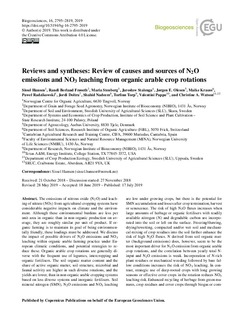| dc.description.abstract | The emissions of nitrous oxide (N2O) and leaching of nitrate (NO3) from agricultural cropping systems have considerable negative impacts on climate and the environment. Although these environmental burdens are less per unit area in organic than in non-organic production on average, they are roughly similar per unit of product. If organic farming is to maintain its goal of being environmentally friendly, these loadings must be addressed. We discuss the impact of possible drivers of N2O emissions and NO3 leaching within organic arable farming practice under European climatic conditions, and potential strategies to reduce these. Organic arable crop rotations are generally diverse with the frequent use of legumes, intercropping and organic fertilisers. The soil organic matter content and the share of active organic matter, soil structure, microbial and faunal activity are higher in such diverse rotations, and the yields are lower, than in non-organic arable cropping systems based on less diverse systems and inorganic fertilisers. Soil mineral nitrogen (SMN), N2O emissions and NO3 leaching are low under growing crops, but there is the potential for SMN accumulation and losses after crop termination, harvest or senescence. The risk of high N2O fluxes increases when large amounts of herbage or organic fertilisers with readily available nitrogen (N) and degradable carbon are incorporated into the soil or left on the surface. Freezing/thawing, drying/rewetting, compacted and/or wet soil and mechanical mixing of crop residues into the soil further enhance the risk of high N2O fluxes. N derived from soil organic matter (background emissions) does, however, seem to be the most important driver for N2O emission from organic arable crop rotations, and the correlation between yearly total N-input and N2O emissions is weak. Incorporation of N-rich plant residues or mechanical weeding followed by bare fallow conditions increases the risk of NO3 leaching. In contrast, strategic use of deep-rooted crops with long growing seasons or effective cover crops in the rotation reduces NO3 leaching risk. Enhanced recycling of herbage from green manures, crop residues and cover crops through biogas or composting may increase N efficiency and reduce N2O emissions and NO3 leaching. Mixtures of legumes (e.g. clover or vetch) and non-legumes (e.g. grasses or Brassica species) are as efficient cover crops for reducing NO3 leaching as monocultures of non-legume species. Continued regular use of cover crops has the potential to reduce NO3 leaching and enhance soil organic matter but may enhance N2O emissions. There is a need to optimise the use of crops and cover crops to enhance the synchrony of mineralisation with crop N uptake to enhance crop productivity, and this will concurrently reduce the long-term risks of NO3 leaching and N2O emissions. | |

